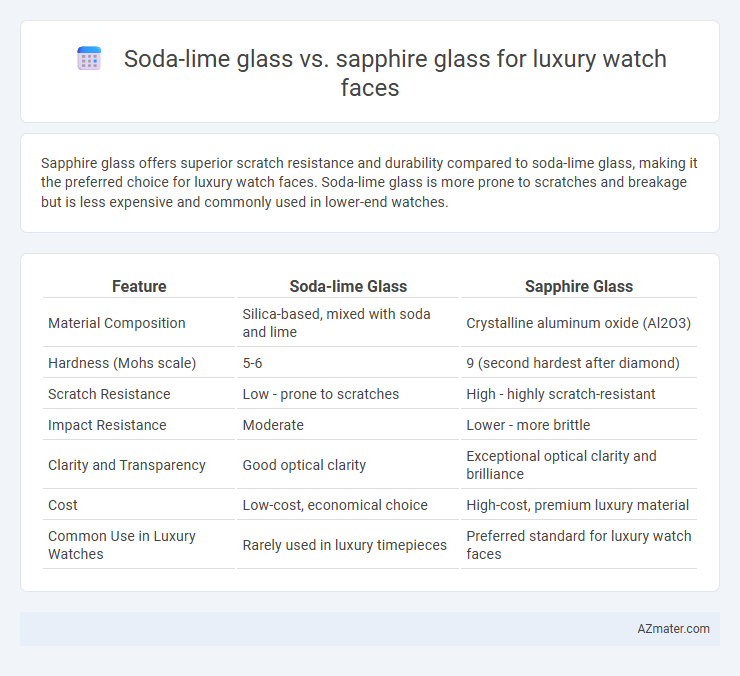Sapphire glass offers superior scratch resistance and durability compared to soda-lime glass, making it the preferred choice for luxury watch faces. Soda-lime glass is more prone to scratches and breakage but is less expensive and commonly used in lower-end watches.
Table of Comparison
| Feature | Soda-lime Glass | Sapphire Glass |
|---|---|---|
| Material Composition | Silica-based, mixed with soda and lime | Crystalline aluminum oxide (Al2O3) |
| Hardness (Mohs scale) | 5-6 | 9 (second hardest after diamond) |
| Scratch Resistance | Low - prone to scratches | High - highly scratch-resistant |
| Impact Resistance | Moderate | Lower - more brittle |
| Clarity and Transparency | Good optical clarity | Exceptional optical clarity and brilliance |
| Cost | Low-cost, economical choice | High-cost, premium luxury material |
| Common Use in Luxury Watches | Rarely used in luxury timepieces | Preferred standard for luxury watch faces |
Introduction to Watch Glass Materials
Soda-lime glass, commonly used in everyday watch faces, offers affordability and decent scratch resistance but lacks the premium durability required for luxury timepieces. Sapphire glass, a synthetic crystal renowned for its exceptional hardness (9 on the Mohs scale), provides superior scratch resistance and clarity, making it the preferred choice for high-end luxury watches. Its ability to maintain pristine appearance under extreme conditions reinforces its status as the optimal material for premium watch faces.
What is Soda-Lime Glass?
Soda-lime glass is a widely used type of glass composed primarily of silica, sodium oxide, and calcium oxide, known for its affordability and ease of manufacture. This glass type offers moderate scratch resistance and clarity, making it common in everyday watch faces but less durable compared to premium options. In luxury watches, soda-lime glass is often considered a budget-friendly alternative to more resilient materials like sapphire glass, which provides superior hardness and scratch resistance.
What is Sapphire Glass?
Sapphire glass is a synthetic crystal composed primarily of aluminum oxide, renowned for its exceptional hardness and scratch resistance, making it an ideal material for luxury watch faces. Unlike soda-lime glass, which is more prone to scratches and breakage, sapphire glass ranks 9 on the Mohs hardness scale, just below diamond, ensuring superior durability and clarity. This high level of toughness and transparency enhances the watch's aesthetic appeal and longevity, justifying its premium cost in high-end timepieces.
Durability and Scratch Resistance Comparison
Sapphire glass exhibits exceptional durability and superior scratch resistance compared to soda-lime glass, commonly used in luxury watch faces for its hardness ranking 9 on the Mohs scale, contrasted with soda-lime's lower abrasion resistance. While soda-lime glass is more prone to scratches and impact damage, sapphire glass withstands everyday wear, maintaining clarity and aesthetic appeal over time. The high cost of sapphire glass is justified by its unparalleled durability and resistance, essential attributes for premium luxury watches.
Clarity and Aesthetic Appeal
Sapphire glass offers superior clarity and scratch resistance, maintaining its brilliance and transparency over time, which enhances the luxury watch's aesthetic appeal. Soda-lime glass, although more affordable and commonly used, tends to be less clear and more prone to scratches, diminishing the overall visual elegance of high-end timepieces. The exceptional hardness of sapphire glass ensures a pristine, mirror-like finish that complements the premium design of luxury watches.
Cost Differences and Value for Money
Soda-lime glass offers a budget-friendly option for luxury watch faces with moderate scratch resistance but lower durability, making it less ideal for long-term value. Sapphire glass, despite its higher upfront cost, delivers superior scratch resistance and strength, enhancing longevity and maintaining a premium appearance. The increased investment in sapphire glass provides better value for money through lasting clarity and durability in luxury timepieces.
Weight and Comfort on the Wrist
Soda-lime glass is significantly heavier than sapphire glass, impacting overall wrist comfort during extended wear. Sapphire glass offers superior lightness and durability, reducing strain and enhancing comfort for luxury watch users. The reduced weight of sapphire glass contributes to a more balanced and less obtrusive feel on the wrist.
Common Uses in Luxury Watch Brands
Sapphire glass is predominantly used in luxury watches due to its superior scratch resistance and clarity, with brands like Rolex, Omega, and Patek Philippe favoring it for premium models. Soda-lime glass, being less durable and more prone to scratches, is uncommon in luxury watch faces but may appear in more affordable or vintage-inspired designs. The choice between soda-lime and sapphire glass significantly affects the watch's durability, visual appeal, and market positioning within the luxury segment.
Maintenance and Care Requirements
Soda-lime glass requires more frequent maintenance due to its lower scratch resistance, making it prone to visible wear and minor damages that necessitate polishing or replacement over time. Sapphire glass offers superior durability and scratch resistance, significantly reducing the need for repairs and maintaining a pristine appearance with minimal upkeep. Regular cleaning with a soft cloth to remove fingerprints and occasional professional inspections suffice to preserve the luxury watch face crafted from sapphire glass.
Choosing the Best Glass for Your Luxury Watch
Sapphire glass offers superior scratch resistance and exceptional hardness, making it the preferred choice for luxury watch faces that demand durability and clarity. Soda-lime glass, while more affordable and easier to manufacture, lacks the hardness to resist scratches and daily wear, making it less suitable for premium timepieces. Opting for sapphire glass ensures long-lasting brilliance and protection, preserving the watch's aesthetic and value over time.

Infographic: Soda-lime glass vs Sapphire glass for Luxury watch face
 azmater.com
azmater.com